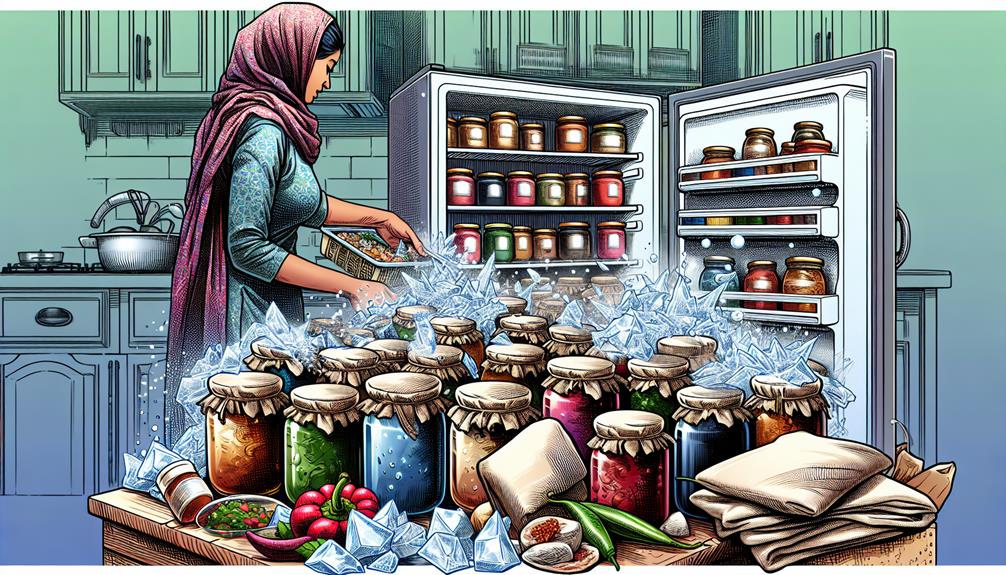Preserving your summer flavors, maximizing your pantry space, and ensuring a year-round supply of homemade spreads are all compelling reasons to freeze jam. You'll find that with a little preparation and the right materials, you can easily extend the life of your delicious concoctions.
First, you need to ensure your jam is suitable for freezing—high sugar and pectin content jams tend to freeze better.
Next, you'll select the appropriate containers—plastic or glass—that can withstand temperature changes without cracking. It's crucial to leave adequate headspace at the top of the container to allow the jam to expand as it freezes.
But before you seal that lid tight, there's an important step you shouldn't overlook, one that could mean the difference between enjoying a perfect spread or facing a messy disappointment.
Key Takeaways
- Jams with high pectin levels freeze better.
- Fruits like apples, citrus, and grapes are ideal for freezing.
- Low-pectin fruits may require additional pectin for a firmer set.
- Choose freezer-safe containers with adequate headspace.
Selecting Suitable Jams
When you're ready to preserve the bounty of sweet flavors, choosing the right type of jam for freezing is a crucial step to ensure quality and enjoyment. Not all jams freeze equally well, so it's important to consider the preservation methods and pectin levels to make the most of your efforts.
High pectin levels help jams set properly and also contribute to a better texture after freezing and thawing. Fruits like apples, citrus, and grapes naturally have high pectin, making them ideal candidates for jam that you plan to freeze. Conversely, low-pectin fruits, such as strawberries or peaches, might require the addition of commercial pectin to achieve a firmer set that withstands freezing.
Also, pay attention to the sugar content. Sugar acts as a preservative and helps maintain the jam's color, texture, and flavor during freezing. If you're making a low-sugar jam, you may need to consume it more quickly after thawing, as it won't keep as long as its higher-sugar counterparts.
Lastly, consider the containers you'll use. Opt for freezer-safe jars or containers that leave enough headspace to accommodate the expansion of the jam as it freezes. This detail ensures your jam stays in great condition from the freezer to your table.
Preparing Jam for Freezing
To prepare your jam for freezing, first ensure it has cooled completely after cooking to preserve its texture and flavor integrity. Cooling to room temperature before transferring to the freezer prevents ice crystal formation, which can ruin the jam consistency.
Once cooled, check the consistency. Your jam should be thick enough to cling to a spoon but not so solid that it doesn't move when tilted. If it's too runny, consider cooking it a bit longer next time, or make ingredient adjustments. Pectin levels or the type of sugar used can affect how well your jam sets, so tweak these accordingly.
When the consistency is just right, spoon your jam into freezer-safe containers. Leave about a half-inch of space at the top to allow for expansion during freezing; this keeps the container from cracking or the jam from spilling over. Seal the containers tightly to avoid freezer burn, which can sap the flavor from your jam.
Label each container with the date and type of jam before placing it in the freezer. This helps you keep track of how long it's been stored and ensures you use the oldest batches first for the best quality.
Container Choices and Preparation
Having prepared your jam and checked its consistency, it's crucial to select the right containers for freezing that will protect its freshness and flavor. Your jar selection is vital in this step. You'll want to opt for containers that are freezer-safe to prevent any cracking at low temperatures. Glass jars specifically designed for freezing are ideal, but if you're using standard mason jars, make sure they've a wide top to allow for the jam's expansion when it freezes.
Before filling, ensure your containers and lids are impeccably clean to avoid any contamination. Lids sterilization is a simple yet critical step. Boil the lids for a few minutes or use a dishwasher with a sterilize cycle to eliminate any harmful bacteria.
Here are some key pointers to remember:
- Choose freezer-safe containers: Prevent cracks and breaks.
- Leave headspace: Allow for expansion during freezing.
- Sterilize lids: Boil or use a dishwasher's sterilize cycle.
- Check for seal integrity: Ensure lids fit tightly to avoid freezer burn.
- Label your containers: Write the date and type of jam for easy identification.
The Freezing Process
Once you've chosen the appropriate containers and prepped them as described, you're ready to proceed with the freezing process, ensuring your jam remains fresh and delicious for months to come.
Start by spooning the jam into the containers, leaving about a half-inch of space at the top to allow for expansion as the jam freezes. This headspace is crucial to prevent the containers from cracking or the lids from popping off.
Next, secure the lids tightly. If you're using plastic wrap or freezer paper as an extra seal, make sure it's snug against the surface of the jam to reduce air exposure, which can cause texture changes. Gently tap the containers on the countertop to remove any air bubbles before sealing.
Now, place your containers in the coldest part of the freezer, avoiding the door area where temperature fluctuations are more common. This consistency in temperature helps to maintain the quality of the jam.
While freeze drying benefits include extended shelf life and nutrient preservation, remember that freezing your jam is different and can result in slight texture changes once thawed. However, these changes are typically minimal, and your jam should still spread smoothly on your favorite bread or pastry.
Enjoy your homemade jam any time of the year!
Thawing and Enjoying Frozen Jam
After your jam has been safely stored in the freezer, it's time to learn the best method for thawing it to preserve its fresh taste and consistency. You'll want to ensure that your jam returns to the perfect spread consistency for toast compatibility and other uses.
Here are some practical steps to thaw your frozen jam:
- Move the jam from the freezer to the refrigerator the night before you plan to use it, allowing it to thaw slowly and evenly.
- Keep the jam container sealed while thawing to prevent any condensation from watering down the jam.
- Once thawed, stir the jam to recombine any separated ingredients, ensuring a uniform texture.
- If you're in a hurry, submerge the sealed jam container in cold water to speed up the thawing process, changing the water every 30 minutes.
- Avoid using a microwave to thaw your jam, as it can unevenly heat and change the flavor and spread consistency.
To enjoy your jam at its best, give it a few stirs after it's completely thawed. This will help maintain a smooth consistency that's perfect for spreading on toast, swirling into yogurt, or topping off your favorite dessert. Remember, patience is key to preserving the delicious, homemade taste of your jam.

